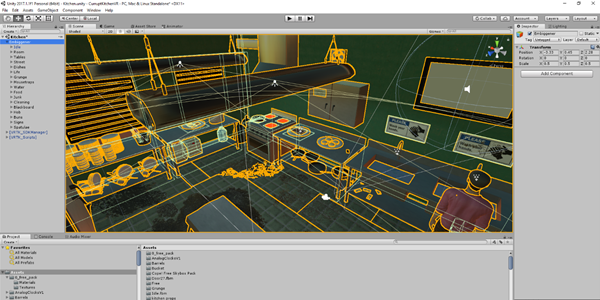
January 15, 2018, by Stuart Moran
When Law and Computer Science Collide: How an interdisciplinary project is letting me do more than I could on my own
It’s not that I wasn’t interested in using technology in my research; I’m just not sure I had ever seen a way to combine virtual reality with food regulation, my rather specialist research area. So it was with some trepidation that I stepped into a meeting with Stuart Moran and Jan Mayer-Sahling, which has the tantalising title Digital Engagement Opportunity. I’m not a technological novice. By the standards of legal academia I’m pretty good with computers, and I am the sort of person who is willing to do research outside my narrow comfort zone. However, this was something new. It was intriguing and exciting, but at the same time I wasn’t sure of its value.
Allow me to wind back. I’m a lawyer by trade, and I spent some time in practice advising food business on their regulatory compliance. When I returned to academia I developed a research interest in food regulation. My PhD involved interviewing regulators and examining documentation in order to determine how the state responds to outbreaks of food-borne illness. Through this research I developed an interest in whistleblowing; why didn’t the kitchen staff, who knew that the business they were working in wasn’t complying with food safety requirements, speak up? Job insecurity and powerlessness played important roles.
Jan Mayer-Sahling, Professor of Political Science in the School of Politics, shared my interest in whistleblowing. Through his research projects on corruption in public administration he had developed an interest in exploring why individuals act in a corrupt manner. Stuart has met both of us separately, and brought us together to explore whether there might be an opportunity to build digital engagement from our shared interest. We were shown a variety of amazing projects, and I couldn’t imagine that something as good as those could stem from our research. I was wrong; or at least I hope that I am.
Having decided that there could be an opportunity to develop something, we had a meeting with Martin Flintham. We discussed some ideas, and settled on a VR game focusing on corruption and compliance. This would allow is to place members of the public in different situations and explore their corruptness and their willingness to comply with regulation; and to demonstrate the consequences of their actions. We had a number of ideas for the setting; a car wash; a shop; even a boat. However, we decided on a kitchen in a restaurant business. Kitchens are highly regulated (the hyperlinks are not light reading), and offer opportunities for non-compliance and corruption that can have drastic effects on individuals and communities. The opportunities to engage users with the consequences of their actions, and to explore the reasons behind their decisions is huge. In order to make the game a reality, Paul Tennent came on board.
The process of developing the game has been enjoyable. We have had regular meeting where we have discussed ideas and shaped the development. We have got rid of ideas (you don’t have to draft food safety documentation) and added new ones (hungry customers increasing the pressure on the player); we have played demos, both on a table and in the virtual world, and made videos; we have created hypothesis, and considered the data that game can collect; and we have expanded our knowledge and experience. I’m sure Stuart, Paul and Martin know more than they have ever wanted to about food hygiene regulations. I have learned a lot about technology and it’s potential. I have also learned about conducting a digital project, and my five key take aways are below
1. I now appreciate the huge potential for using technology to enhance research in area where I couldn’t see how we would use it. I never imagined using a virtual reality game to examine regulatory compliance, but as the project has developed the potential has become more and more exciting.
2. The public engagement potential of technology is tremendous. When I tell people, whether it is my students, my friends, or people that I meet that I am involved in the development of a Virtual Reality game which engages with my research they are excited. They want to know more. This is not always the case when I talk about my research interests.
3. That interdisciplinary working has the potential to be incredible stimulating and creative. Engaging with academics from Politics and Computer Science has allowed me to develop my thinking, and is undoubtedly improving me as an academic. Both the research flowing from the collaboration, and the game itself, are something that I could never have done on my own.
4. That technology is not a silver bullet. The ideas still have to be thought through in detail, and worked out in depth. The game initially began as something that you could play on a table top; and the research is based on important and interesting questions. Just because something has a technological aspect
5. Small is beautiful. The game is not a sprawling adventure that seeks to replicate the complexities of life. It is a hopefully fun time-limited game that will make the player think, and allow us to explore corruption and non-compliance.
The project has been an excellent experience. I can’t wait to see the game in the field, and watch users play it. I hope that it will tell us something interesting about compliance and corruption, but even if it doesn’t, it should make the users think about their actions, and probably not look at the local chip shop in the same way in future.
Next blog in series: Corrupt Kitchen VR Dev-Diary 3
Previous blog in series: Corrupt Kitchen VR Dev-Diary 2

[…] When Law and Computer Science Collide: How an interdisciplinary project is letting me do more than I… […]